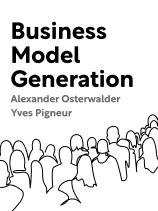

This article is an excerpt from the Shortform book guide to "Business Model Generation" by Alexander Osterwalder and Yves Pigneur. Shortform has the world's best summaries and analyses of books you should be reading.
Like this article? Sign up for a free trial here .
What is Osterwalder and Pigneur’s book Business Model Generation about? What are the nine elements that make up a business model?
In their book Business Model Generation, innovation experts Alexander Osterwalder and Yves Pigneur propose a framework for designing a successful, holistic business model. Co-created by 470 practitioners from across 45 countries, the template consists of nine elements, which can be combined in different ways to tailor-design a business model for any venture.
This Business Model Generation book review takes a look at the book’s impact, authors’ backgrounds, and critical reception.
About the Authors
Dr. Alexander Osterwalder is an entrepreneur and highly respected strategy and innovations expert. Osterwalder has co-authored a number of books on the subject of business strategy and innovation:
- High-Impact Tools for Teams: 5 Tools to Align Team Members, Build Trust, and Get Results Fast, co-authored with Stefano Mastrogiacomo
- Testing Business Ideas: A Field Guide for Rapid Experimentation, co-authored with David J. Bland
Connect with Alexander Osterwalder:
Dr. Yves Pigneur is a professor at the University of Lausanne. He has co-authored several books with Alexander Osterwalder, and he is renowned for his expertise in business strategy and innovation.
Connect with Yves Pigneur:
The Book’s Impact
Dr. Alexander Osterwalder and Dr. Yves Pigneur originally worked together on a Ph.D. dissertation on the topic of business model innovation. After Osterwalder documented their approach in his business blog, businesses around the world, including Ericsson and Deloitte, began applying their method.
Osterwalder and Pigneur recognized that there was a demand for their book. However, they also recognized that the market was already saturated with strategy and management books with which they would need to compete. Therefore, they decided to implement their own business model process to come up with a way to finance, produce, and competitively position the book.
Instead of seeking a traditional publisher, they launched a subscription-based online platform to share their research. This platform not only financed the production of the book but facilitated co-creation with 470 global practitioners to create the book.
The authors did not have the support of a publishing house nor a marketing budget. Despite this, Business Model Generation quickly gained traction, is now required reading on many management courses, and has since sold over a million copies in 40 languages.
The book was eventually published by Wiley in 2010. Osterwalder and Pigneur have since co-authored a number of books together including:
- Business Model You: A One-Page Method For Reinventing Your Career, co-authored with Timothy Clark
- The Invincible Company: How to Constantly Reinvent Your Organization with Inspiration From the World’s Best Business Models, co-authored with Alan Smith, and Frederic Etiemble
- Value Proposition Design: How to Create Products and Services Customers Want, co-authored with Gregory Bernarda, and Alan Smith
Osterwalder and Pigneur have continued to develop their successful collaborations. Strategyzer, the consultancy firm they co-founded in 2010, provides online courses, applications, and services to help organizations build “invincible companies.” Millions of business practitioners and leading global companies including Microsoft, Coca-Cola, Nestlé, MasterCard, Sony, and Fujitsu, rely upon the practical tools that they’ve developed.
Strategyzer provides a downloadable template for the Business Model Canvas, as well as other useful tools to accompany the book.
The Book’s Critical Reception
Many reviewers comment that the book is practical and engaging. They find the process of evaluating or designing a business model based on the Canvas easy to follow, and they find the tools and strategies covered in the book very useful.
However, some reviewers have commented that the book suffers from “style over substance” because it lacks the necessary depth to execute a business plan. These reviewers suggest that the book is more suited to beginners rather than professionals. Other reviewers have commented that the layout of the book is too disjointed, and they feel that the authors’ attempt to cover too many different methodologies diminishes the overall effectiveness of the book. Finally, some reviewers have commented that the book is overly repetitive with many of the tools, processes, and case studies overlapping.
Commentary on the Book’s Approach
In their book Business Model Generation, Osterwalder and Pigneur provide a template for brainstorming and visualizing the overarching elements that make up a successful, holistic business model. It then demonstrates how to use this template to analyze or adapt existing business models, or design new models. In addition, it weaves in case studies and strategies to illustrate practical ways that businesses can use the template to successfully position their own business models.
Commentary on the Book’s Organization
There are six chapters: Canvas, Patterns, Design, Strategy, Process, and Outlook. The first two chapters explain what makes a successful business model and then describes different business models and how businesses can apply them. The authors provide supporting arguments from academics and strategists, as well as illustrations of existing business models to demonstrate each point.
However, from the third chapter onwards, the presentation of the concepts becomes less focused. The authors attempt to present a multitude of existing techniques and processes to use in conjunction with their business model template. However, these techniques originate from multiple sources and many of the tools and processes overlap. As a result, the last four chapters of the book suffer heavily from repetition.

———End of Preview———
Like what you just read? Read the rest of the world's best book summary and analysis of Alexander Osterwalder and Yves Pigneur's "Business Model Generation" at Shortform .
Here's what you'll find in our full Business Model Generation summary :
- The nine elements that make up any successful business model
- Different ways you can combine these elements to create business model patterns
- Techniques you can use to generate innovative ideas






